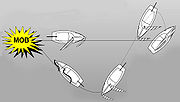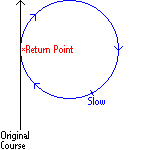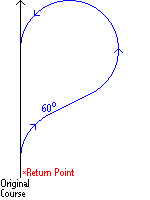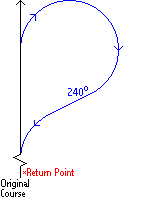
Anderson turn
Encyclopedia
A man overboard rescue turn is a sailing maneuver usually implemented immediately when it is learned that there is a man overboard
. To maneuver closer to the person's location, implementations of the principles described are: the quick turn (also known as the Q-turn or the figure eight turn), the Anderson turn, the Williamson turn, and the Scharnow turn.
 The quick turn is the traditional response to a man overboard
The quick turn is the traditional response to a man overboard
emergency on a sailboat
. Despite many new approaches, it is still a robust strategy and often the best method. Certainly when the crew is short handed, or when the vessel is in heavy weather, the quick turn method has a lot of merit because it avoids a jibe
.
As is shown in the drawing, the quick turn is essentially a figure eight.
On a sailboat it consists of the following steps:

The Anderson turn is a maneuver used to bring a ship or boat back to a point it previously passed through, often for the purpose of recovering a man overboard
, an emergency situation in almost all circumstances.
The Anderson turn is most appropriate when the point to be reached remains clearly visible. For other situations, a Scharnow turn or a Williamson turn might be more appropriate. Both will require more time before returning to the point in question.
If dealing with a man overboard, always bring the vessel upwind of the person. Stop the vessel in the water with the person well forward of the propellers.

The Williamson turn is a maneuver used to bring a ship or boat under power back to a point it previously passed through, often for the purpose of recovering a man overboard. It was named for John Williamson, USNR, who used it in 1943. However, according to Uncommon Carriers by John McPhee
, the maneuver was originally called the "Butakov pipe" and was used in the Russo-Japanese War
as a way of keeping guns at the same distance from an enemy.
The Williamson turn is most appropriate at night or in reduced visibility, or if the point can be allowed to go (or already has gone) out of sight, but is still relatively near. For other situations, an Anderson turn (quickest method) or a Scharnow turn might be more appropriate. The choice will in large part depend on prevailing wind and weather conditions. It was also used by U.S. Navy nuclear submarine
s to clear their sonar dead zones.
If dealing with a man overboard, always bring the vessel upwind of the person. Stop the vessel in the water with the person well forward of the propellers.

The Scharnow turn is a maneuver used to bring a ship or boat back to a point it previously passed through, often for the purpose of recovering a man overboard. It was developed by and named for Ulrich Scharnow.
The Scharnow turn is most appropriate when the point to be reached is significantly further astern than the vessel's turning radius. For other situations, an Anderson turn or a Williamson turn might be more appropriate.
If dealing with a man overboard, always bring the vessel upwind of the person. Stop the vessel in the water with the person well forward of the propellers.
Man overboard
Man overboard is a situation in which a person has fallen from a boat or ship into the water and is in need of rescue. Whoever sees the person's fall should shout "man overboard" to alert other crew members and attempt to maintain visual contact with the person in the water...
. To maneuver closer to the person's location, implementations of the principles described are: the quick turn (also known as the Q-turn or the figure eight turn), the Anderson turn, the Williamson turn, and the Scharnow turn.
Quick turn

Man overboard
Man overboard is a situation in which a person has fallen from a boat or ship into the water and is in need of rescue. Whoever sees the person's fall should shout "man overboard" to alert other crew members and attempt to maintain visual contact with the person in the water...
emergency on a sailboat
Sailboat
A sailboat or sailing boat is a boat propelled partly or entirely by sails. The term covers a variety of boats, larger than small vessels such as sailboards and smaller than sailing ships, but distinctions in the size are not strictly defined and what constitutes a sailing ship, sailboat, or a...
. Despite many new approaches, it is still a robust strategy and often the best method. Certainly when the crew is short handed, or when the vessel is in heavy weather, the quick turn method has a lot of merit because it avoids a jibe
Jibe
A jibe or gybe is a sailing maneuver where a sailing vessel turns its stern through the wind, such that the wind direction changes from one side of the boat to the other...
.
As is shown in the drawing, the quick turn is essentially a figure eight.
On a sailboat it consists of the following steps:
- Change course to a beam reach and hold for 15 seconds
- Head into the wind and tackTacking (sailing)Tacking or coming about is a sailing maneuver by which a sailing vessel turns its bow through the wind so that the direction from which the wind blows changes from one side to the other...
, leave the jibJibA jib is a triangular staysail set ahead of the foremast of a sailing vessel. Its tack is fixed to the bowsprit, to the bow, or to the deck between the bowsprit and the foremost mast...
fluttering - Veer off until the boat is at a broad reach
- Turn upwindWindward and leewardWindward is the direction upwind from the point of reference. Leeward is the direction downwind from the point of reference. The side of a ship that is towards the leeward is its lee side. If the vessel is heeling under the pressure of the wind, this will be the "lower side"...
until the vessel is pointing at the victim; at this point the vessel should be on a close reach. - Slacken the mainsailMainsailA mainsail is a sail located behind the main mast of a sailing vessel.On a square rigged vessel, it is the lowest and largest sail on the main mast....
until the vessel comes to a stop with the victim in the leeWindward and leewardWindward is the direction upwind from the point of reference. Leeward is the direction downwind from the point of reference. The side of a ship that is towards the leeward is its lee side. If the vessel is heeling under the pressure of the wind, this will be the "lower side"...
side of the boat
Anderson turn

The Anderson turn is a maneuver used to bring a ship or boat back to a point it previously passed through, often for the purpose of recovering a man overboard
Man overboard
Man overboard is a situation in which a person has fallen from a boat or ship into the water and is in need of rescue. Whoever sees the person's fall should shout "man overboard" to alert other crew members and attempt to maintain visual contact with the person in the water...
, an emergency situation in almost all circumstances.
The Anderson turn is most appropriate when the point to be reached remains clearly visible. For other situations, a Scharnow turn or a Williamson turn might be more appropriate. Both will require more time before returning to the point in question.
- If the turn is in response to a man overboard, stop the engines.
- Put the rudder over full. If in response to a man overboard, put the rudder toward the person (e.g., if the person fell over the starboard side, put the rudder over full to starboard).
- When clear of the person, go all ahead full, still using full rudder.
- After deviating from the original course by about 240 degrees (about 2/3 of a complete circle), back the engines 2/3 or full.
- Stop the engines when the target point is 15 degrees off the bow. Ease the rudder and back the engines as required.
If dealing with a man overboard, always bring the vessel upwind of the person. Stop the vessel in the water with the person well forward of the propellers.
Williamson turn

The Williamson turn is a maneuver used to bring a ship or boat under power back to a point it previously passed through, often for the purpose of recovering a man overboard. It was named for John Williamson, USNR, who used it in 1943. However, according to Uncommon Carriers by John McPhee
John McPhee
John Angus McPhee is an American Pulitzer Prize-winning writer, widely considered one of the pioneers of creative nonfiction....
, the maneuver was originally called the "Butakov pipe" and was used in the Russo-Japanese War
Russo-Japanese War
The Russo-Japanese War was "the first great war of the 20th century." It grew out of rival imperial ambitions of the Russian Empire and Japanese Empire over Manchuria and Korea...
as a way of keeping guns at the same distance from an enemy.
The Williamson turn is most appropriate at night or in reduced visibility, or if the point can be allowed to go (or already has gone) out of sight, but is still relatively near. For other situations, an Anderson turn (quickest method) or a Scharnow turn might be more appropriate. The choice will in large part depend on prevailing wind and weather conditions. It was also used by U.S. Navy nuclear submarine
Nuclear submarine
A nuclear submarine is a submarine powered by a nuclear reactor . The performance advantages of nuclear submarines over "conventional" submarines are considerable: nuclear propulsion, being completely independent of air, frees the submarine from the need to surface frequently, as is necessary for...
s to clear their sonar dead zones.
- Put the rudder over full.
- If in response to a man overboard, put the rudder toward the person (e.g., if the person fell over the starboard side, put the rudder over starboard full).
- After deviating from the original course by about 60 degrees, shift the rudder full to the opposite side.
- When heading about 20 degrees short of the reciprocal, put the rudder amidships so that vessel will turn onto the reciprocal course.
- Bring the vessel upwind of the person, stop the vessel in the water with the person alongside, well forward of the propellers
If dealing with a man overboard, always bring the vessel upwind of the person. Stop the vessel in the water with the person well forward of the propellers.
Scharnow turn

The Scharnow turn is a maneuver used to bring a ship or boat back to a point it previously passed through, often for the purpose of recovering a man overboard. It was developed by and named for Ulrich Scharnow.
The Scharnow turn is most appropriate when the point to be reached is significantly further astern than the vessel's turning radius. For other situations, an Anderson turn or a Williamson turn might be more appropriate.
- Put the rudder over hard. If in response to a man overboard, put the rudder toward the person (e.g., if the person fell over the starboard side, put the rudder over hard to starboard).
- After deviating from the original course by about 240 degrees, shift the rudder hard to the opposite side.
- When heading about 20 degrees short of the reciprocal course, put the rudder amidships so that vessel will turn onto the reciprocal course.
If dealing with a man overboard, always bring the vessel upwind of the person. Stop the vessel in the water with the person well forward of the propellers.

